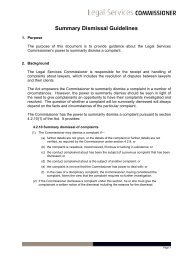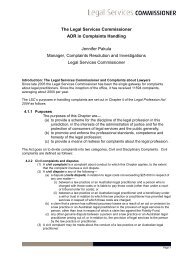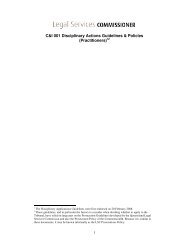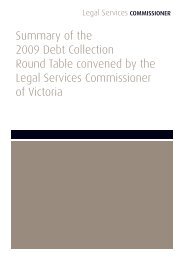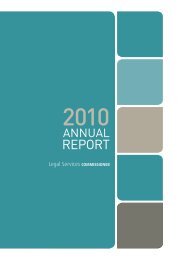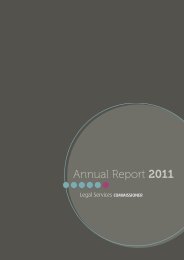LEGAL SERVICES COMMISSIONER ANNUAL REPORT 2012
LEGAL SERVICES COMMISSIONER ANNUAL REPORT 2012
LEGAL SERVICES COMMISSIONER ANNUAL REPORT 2012
Create successful ePaper yourself
Turn your PDF publications into a flip-book with our unique Google optimized e-Paper software.
It is deemed that, in the event of theloss or destruction of an asset, thefuture economic benefits arisingfrom the use of the asset will bereplaced unless a specific decisionto the contrary has been made. Therecoverable amount for most assets ismeasured at the higher of depreciatedreplacement cost and fair value lesscosts to sell. Recoverable amount forassets held primarily to generate netcash inflows is measured at the higherof the present value of future cashflows expected to be obtained from theasset and fair value less costs to sell.Refer to Note 1(j) in relation to therecognition and measurement of nonfinancialassets.Net gain/(loss) on financialinstrumentsNet gain/(loss) on financial instrumentsincludes:• realised and unrealised gains andlosses from revaluations of financialinstruments at fair value;• impairment and reversal ofimpairment for financial instrumentsat amortised cost; and• disposals of financial assets.Revaluations of financial instrumentsat fair valueRefer to Note 1(h) Financialinstruments.Other gains/(losses) from othereconomic flowsOther gains/(losses) from othereconomic flows include the gains orlosses from the revaluation of thepresent value of the long service leaveliability due to changes in the bondinterest rates and transfer of amountsfrom the reserves and/or accumulatedsurplus to net result due to disposalor derecognition or reclassification.(h) Financial instrumentsFinancial instruments arise out ofcontractual agreements that give riseto a financial asset of one entity and afinancial liability or equity instrumentof another entity. Due to the nature ofthe LSC’s activities, certain financialassets and financial liabilities ariseunder statute rather than a contract.Such financial assets and financialliabilities do not meet the definitionof financial instruments in AASB 132Financial Instruments: Presentation.For example, statutory receivablesarising from taxes, fines and penaltiesdo not meet the definition of financialinstruments as they do not arise undercontract.Where relevant, for note disclosurepurposes, a distinction is madebetween those financial assets andfinancial liabilities that meet thedefinition of financial instruments inaccordance with AASB 132 and thosethat do not.The following refers to financialinstruments unless otherwise stated.Categories of non-derivative financialinstrumentsLoans and receivablesLoans and receivables are financialinstrument assets with fixed anddeterminable payments that are notquoted on an active market. Theseassets are initially recognised at fairvalue plus any directly attributabletransaction costs. Subsequent toinitial measurement, loans andreceivables are measured at amortisedcost using the effective interestmethod, less any impairment.Loans and receivables categoryincludes cash and deposits, tradereceivables and other receivables(refer to Note 1(i)).Financial liabilities at amortised costFinancial instrument liabilities areinitially recognised on the date theyare originated. They are initiallymeasured at fair value plus anydirectly attributable transaction costs.Subsequent to initial recognition,these financial instruments aremeasured at amortised cost withany difference between the initialrecognised amount and the redemptionvalue being recognised in profit andloss over the period of the interestbearingliability, using the effectiveinterest rate method.Financial instrument liabilitiesmeasured at amortised cost includeall payables, deposits held andinterest-bearing arrangements otherthan those designated at fair valuethrough profit or loss.(i) Financial assetsCash and depositsCash and deposits comprise of cashon hand and cash at bank.ReceivablesReceivables consist of:• contractual receivables whichinclude mainly debtors in relationto goods and services;• accrued income; and• GST input tax credits recoverable.Contractual receivables are classifiedas financial instruments andcategoried as loans and receivables(refer to Note 1(h) for recognition andmeasurement). Statutory receivables,are recognised and measured similarlyto contractual receivables (except forimpairment), but are not classified asfinancial instruments because they donot arise from a contract.Receivables are subject to impairmenttesting as described below. A provisionfor doubtful receivables is recognisedwhen there is objective evidence thatthe debts may not be collected, and baddebts are written off when identified.Legal Services <strong>COMMISSIONER</strong> Annual Report <strong>2012</strong> 53



